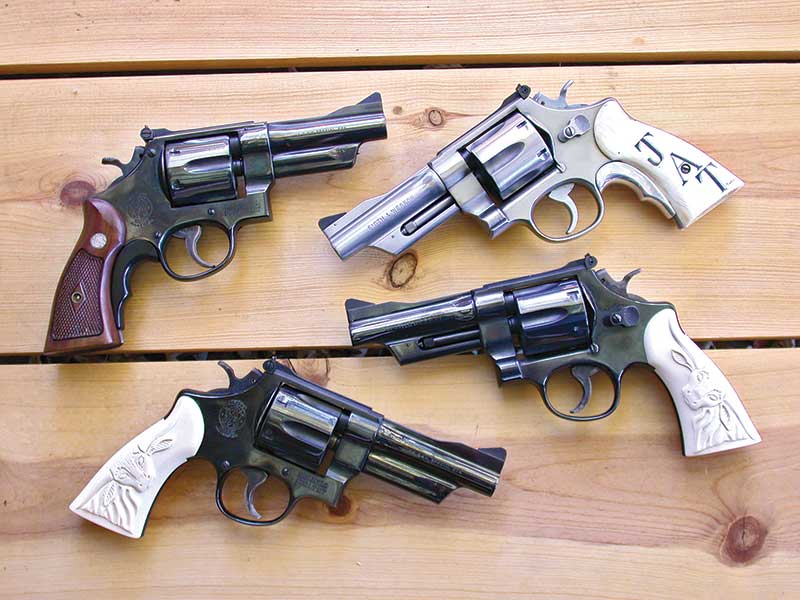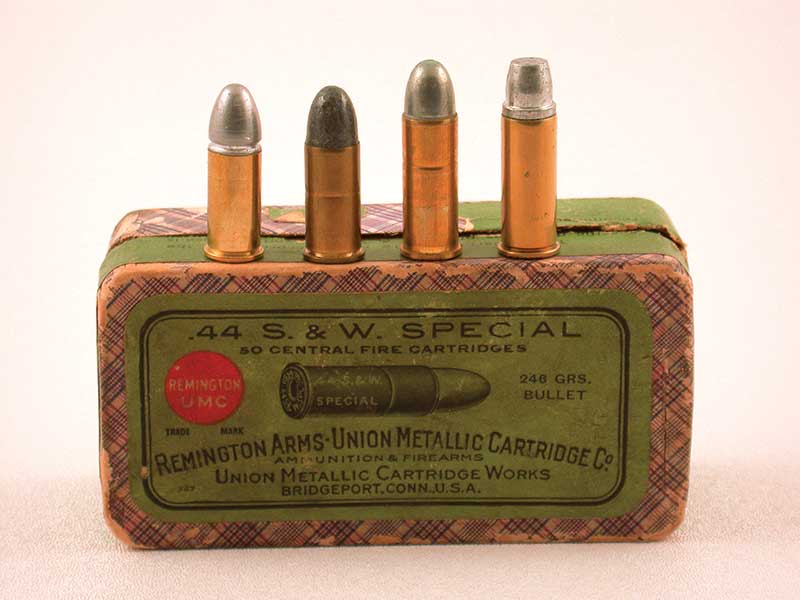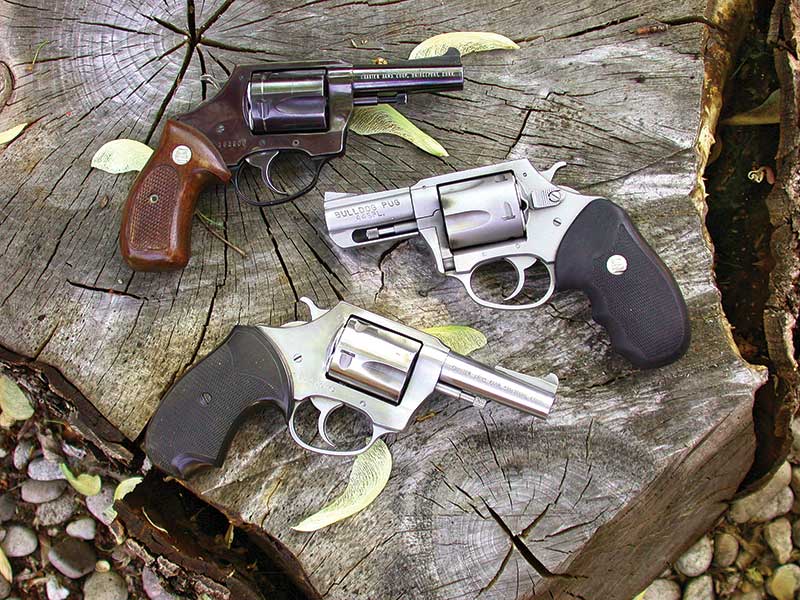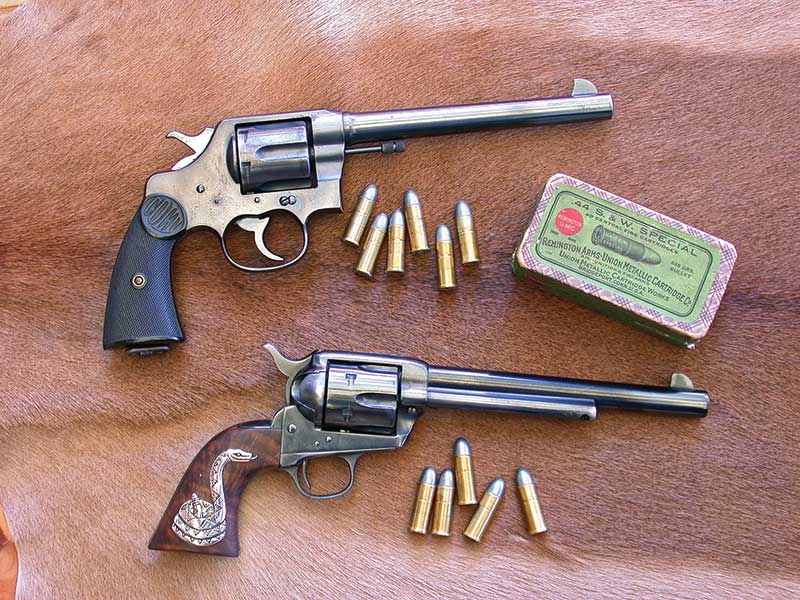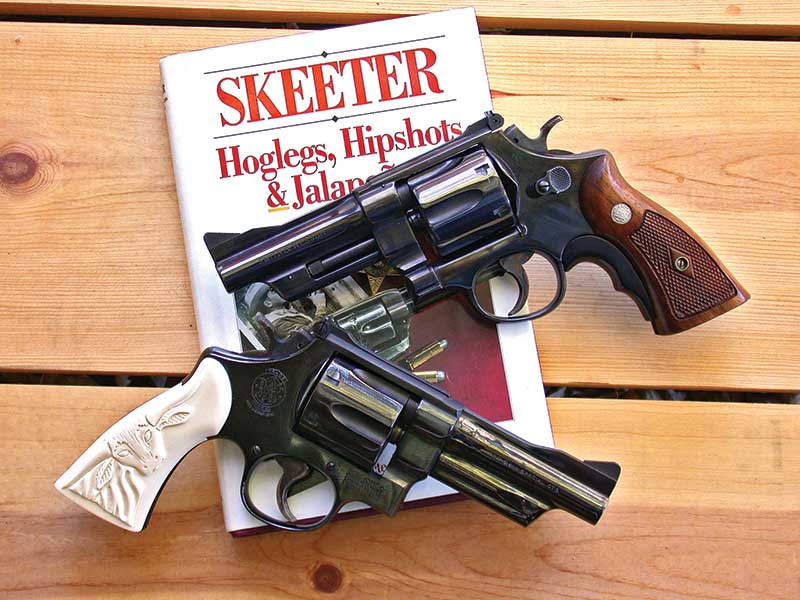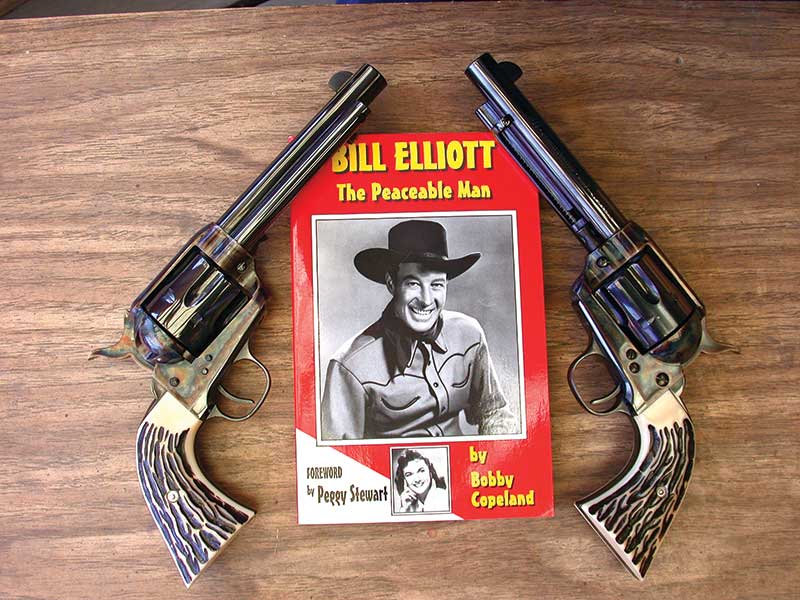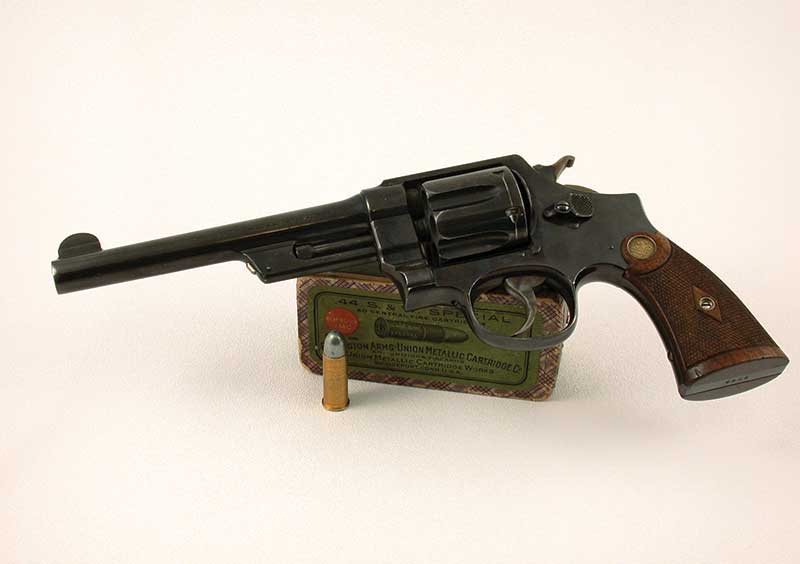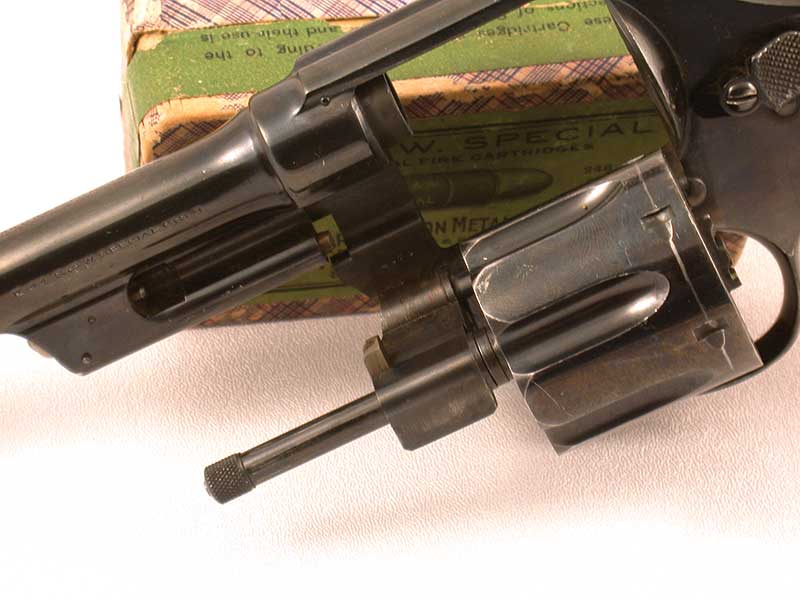A “Special” Happy Birthday!
The .44 Special Turns 100
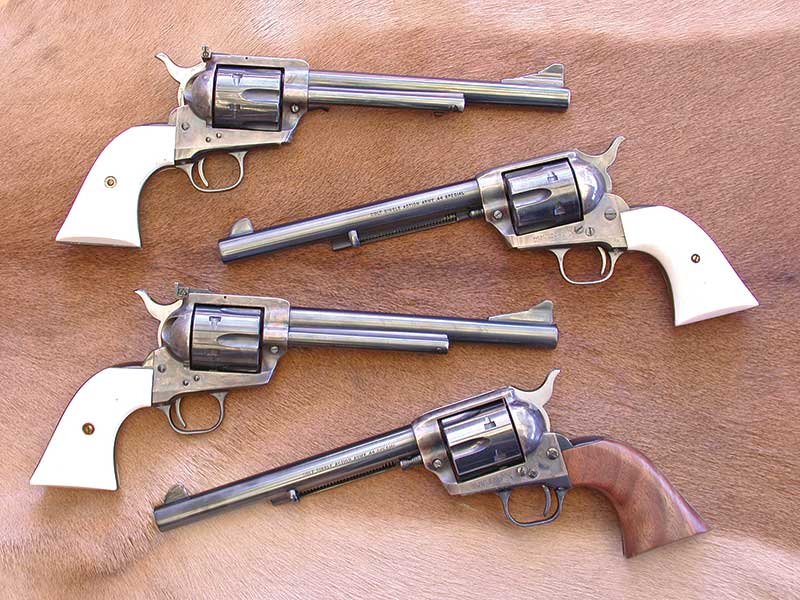
Two generations of great .44 Specials from Colt (above), Second and Third Model New Frontiers
and Single Action Armies. The 1950 Target .44 Special was dropped in 1966 (below, top, left), however,
S&W made a special run of Model 624s in stainless steel (below, top, right) and blue Model 24-3s
(below, bottom, left and right). Carved ivories by Bob Leskovec, ivory scrimshaw by Twyla Taylor.
S&W celebrated the young 20th-century by lengthening the venerable .44 Russian case from .97″ to 1.06″ and creating a new cartridge for the new century called the .44 S&W Special. Both Colt and Smith & Wesson had swing-out cylindered, simultaneous-ejecting, double action revolvers in the 1890s.
Now Smith & Wesson showed what they could really do to produce the finest possible revolver. Their first solid-frame .44 Special, officially known as the .44 Hand Ejector 1st Model, New Century or Model of 1908, was built as a proto-type in 1907. The Triple-Lock is so named because its cylinder locked in three places, at the rear, at the front of the ejector rod and also with a beautifully machined third lock at the front of the frame. This third lock was not really needed except to showcase the precision Smith & Wesson was capable of building into their firearms. The gun was more advanced than its cartridge.
The new .44 Special was a ballistic twin to the .44 Russian in a longer case. It is obvious neither S&W nor ammunition manufacturers knew what they actually had. The Triple-Lock was hampered by the lack of heat-treating while the .44 Special cartridge itself has never been factory loaded to its full potential and it has taken 100 years for ammunition makers to even rise above the original 246-grain roundnose bullet with a velocity of 750 fps. It would fall to experimenters to take the .44 Special to its ultimate performance.
The Triple-Lock only lasted until 1915 when, for a savings of $2 off the retail price, both the third locking feature and the enclosed ejector rod were dropped. The resulting 2nd Model would last until 1940, however, in 1926 the 3rd Model arrived with a return to the enclosed ejector rod. These beautiful sixguns may not have had the third locking feature, however they were heat-treated and well suited to the heavy loads soon to be developed.
The 1926 Model was replaced by what was probably the best of the .44 Hand Ejector series, the 4th Model or, as it is better known, the 1950 Target. The companion fixed-sighted version was known as the .44 Military and, when S&W went to model numbers they became the Model 24 and Model 21 respectively. The run of the wonderful, beautifully-made .44 Hand Ejectors came to an end in 1966 when they seemingly could no longer compete with the sixgun and cartridge they spawned, the .44 Magnum. Connoisseurs knew better.
The Colt And Others
In 1913, Colt first offered the Single Action Army chambered in .44 Special, marked “RUSSIAN AND SMITH & WESSON SPECIAL 44.” Approximately 500 Colt .44 Specials would be manufactured before WWII. Colt chambered its big double action New Service, Target Model and Shooting Master in .44 Special, some of the finest Specials ever offered.
The Colt Single Action 2nd Generations were chambered in .44 Special with the beautiful New Frontier arriving in 1962. The New Frontier had a flattop frame and adjustable rear sight matched up with a ramped front. These grand New Frontiers chambered in .44 Special are more rare than .44 Special 1st Generation Single Actions. In 1976, the 2nd Generation Colts were replaced by the 3rd Generation and, in 1978, the new New Frontiers arrived. By 1982 the New Frontiers were gone and two years later the .44 Special disappeared and has not been seen since chambered in the Single Action Army.
After being assured Colt had no plans to bring back the SAA, Great Western of Los Angeles offered the first replica Single Action in 1954, two years before Colt returned it to production. Once they learned what they were doing, GW built excellent single actions, including those in .44 Special, how-ever, with the return of the original, Great Western’s days were numbered and they disappeared in the early 1960s. In the mid-1980s Bill Grover of Texas Longhorn Arms made “right-handed” single actions with the ejector rod on the left side. His Flattop Target and South Texas Army were some of the finest .44 Specials. TLA closed in the late 1990s.
Elmer Keith
From the late 1920s until 1955, Elmer Keith continually promoted the .44 Special as the ideal sixgun cartridge using his “Keith” bullet weighing 250 grains and pushed to its full potential using first No. 80 powder, which only gave him 1,100 fps, and then Hercules 2400 for 1,200 fps. As a teenager I purchased a copy of Sixguns By Keith, subsequently spending many hours carefully studying the pictures of his many custom sixguns.
Keith’s four Colt Single Action .44 Specials were a 71⁄2″-barreled King short-action, a one-of-a-kind 71⁄2″ Flattop Target, the No. 5 SAA, an extensively customized 51⁄2” Flattop Target Model with a special grip made by combining a Bisley back-strap and Colt SA triggerguard and a 51⁄2″ Flattop Target with Keith-designed folding three leaf rear sight. In addition to Colt Single Action .44 Specials, Keith also used double action Smith & Wessons such as the Triple-Lock and Model 1926. For much of his adult life Keith, lived on the Salmon River in Idaho working as a guide, packer, outfitter, big game hunter, writer, experimenter, you name it and if it had to do with big-bore six-guns he was probably involved.
The Colt Single Action .44 Specials were his everyday working tools. He was not a handgun hunter as we define it today but took many big game animals with sixguns simply because he always had a sixgun with him. In the 1950s, after he moved into town, Keith switched from his beloved Single Action Colts.
The little town of Salmon, Idaho, became famous due to his writings, and he began to carry a 4″ 1950 Target Smith & Wesson .44 Special as his favorite sixgun. As far as Keith was concerned the .44 Special was the “King of Sixgun Cartridges” and for nearly 30 years he proclaimed it as such urging Smith & Wesson to bring out a new gun chambered in a “.44 Special Magnum” loaded to his Heavy .44 Special level. The result in 1956 was the S&W .44 Magnum sixgun and companion Remington .44 Magnum ammunition with a 240-grain bullet at a muzzle velocity 250 fps above Keith’s Heavy .44 Special. Keith was ecstatic and retired his .44 Specials and instead would carry a .44 Magnum daily until his stroke in 1981.
Skeeter Resurrects The Special
Another connoisseur of the .44 Special was Skeeter Skelton, who began his writing career in this very magazine. Skelton also dropped the Special in favor of the .44 Magnum, but soon regretted it. He swapped his 5″ 1950 Target .44 Special for a 4″ .44 Magnum. However, Skeeter soon longed for his Specials realizing there was room for both.
He wrote in 1975 “With full loads the muzzle blast and recoil of the 4″ Model 29, while not as fierce as sometimes described, brought me to the conclusion that the .44 Magnum was not the optimum choice as a law-enforcement gun. While it is certainly true that one well-placed shot from it will anchor any man, there are other considerations …For law-enforcement use I returned a favored 1950 Target .44 Special with 4″ barrel to my holster. After reflecting on my experiences with the .44 Magnum, I even loaded the .44 Special down to a manageable 250-grain 900 fps rate that gave me good DA control and retained more than adequate stopping power.” It would not be long until Skeeter would begin a campaign to resurrect the .44 Special.
If there weren’t any .44 Specials to be had from Colt and Smith & Wesson then the only solution was make your own —exactly what Skeeter did. Starting with a Ruger .357 Blackhawk, the 3-screw Old Model as it is now referred to and which is the same size as the Colt Single Action, and a Smith & Wesson Model 28 Highway Patrolman .357 Magnum, Skeeter set about to have both converted to .44 Special.
Those conversions were grand, but Skeeter did not stop there. He began lobbying both Colt and S&W to return the .44 Special. When 3rd generation Colt .44 Specials arrived, Skeeter announced “Victory At Last” in an article.
Four years later Smith & Wesson heeded Skeeter and came out with the Model 24-3 .44 Special in both 4″ and 61⁄2″ lengths, followed with the Model 624 in the stainless steel. Special runs were offered in both blue and stainless with 3″ barrels. All long gone now. Since then, Smith & Wesson has offered two 5-shot L-frame .44 Specials, the Model 396Ti and 696, however these are gone, too. Clint Smith carried on Skeeter’s campaign and in 2004 Smith & Wesson listened and introduced the Thunder Ranch Special, a 4″ fixed-sight N-frame reminiscent of the 4″ 1926 and .44 Military Models. It is now available in a nickel-plated version.
Today’s .44 Specials
A pocket .44 Special arrived in the 1970s from Charter Arms as the 5-shot Bulldog first in blue, then stainless steel. This has often been the only factory-produced .44 Special available. Today’s .44 Special from Charter Arms is the Bulldog Pug with an enclosed ejector rod. They are handy for defensive purposes. Replica firearms from Italy are also offered in .44 Special, though hard to find. Cimarron offers both their Model P and 1873 Winchester levergun in .44 Special and both are excellent shooters.
USFA is producing all American-made Single Actions rivaling, perhaps even surpassing, the quality of the 1st Generation Colts. USFA offers both the fixed-sighted Single Action and also the original Flattop Target. These are beautifully made, beautifully finished, beautifully fitted and above all beautifully shooting .44 Specials.
From Freedom Arms comes the 5-shot Model 97 in .44 Special. This relatively small sixgun, slightly smaller than the Colt Single Action Army, is capable of handling the heaviest .44 Special loads and is one of the most accurate sixguns I have ever fired. A third single action of note is Gary Reeder’s rendition of Elmer Keith’s No. 5 SAA. This stainless steel revolver is offered as the No. 5 in .44 Special and the slightly larger No. 6 in .44 Magnum. It has fully adjustable sights and is available with many custom extras. Mine is a highly cherished and prized present from Diamond Dot.

Get More Revolver Content Every Week!
Sign up for the Wheelgun Wednesday newsletter here:
